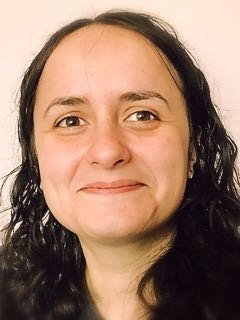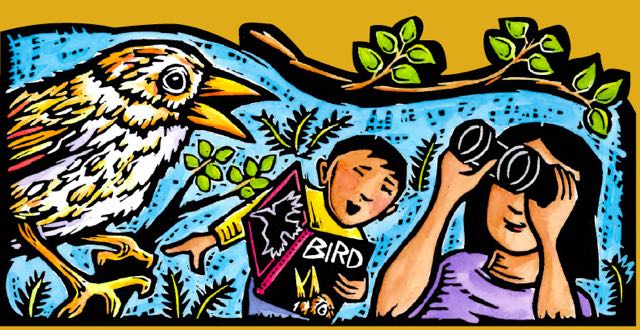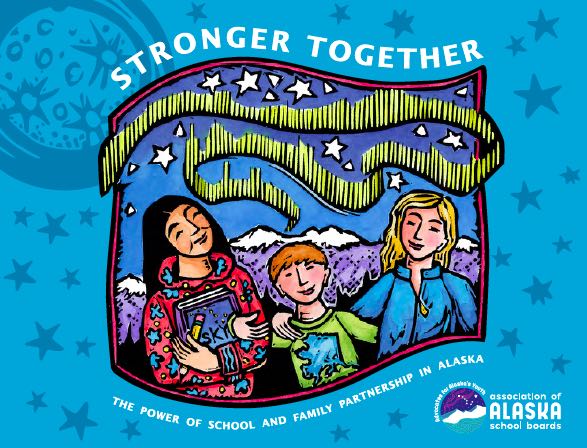Stronger Together: New Family Partnerships Framework for Alaskans

Claudia Plesa, AASB Community Engagement Manager
Across Alaska, and nationally, school staff report a real desire for training and support for effective family partnership approaches. In response, AASB is introducing a new framework, Stronger Together: The Power of Family and School Partnerships.
What is the framework?
Stronger Together: The Power of Family and School Partnerships offers foundational information and practical tools for school staff to strengthen their family partnership practices. Available in digital and hard-copy formats, the framework introduces a series of core building blocks, stories, family partnership planning tools and ideas on how to support family partnerships at a distance. The framework can be found here.

Each building block helps educators understand how to build strong relationships with families that better link learning to families and place. The framework also explores how families can build confidence and link to their student’s learning. Core building blocks include:
- The Family Partnership Mindset
- Strong Relationships
- Cultural Responsive Partnerships
- Links to Learning
- Skills and Confidence
- Co-regulation
The framework, developed with input from school staff across the state, allows staff to build and reflect on existing family partnerships efforts. Each chapter provides stories or examples of family partnership, concrete actionable ideas, and reflection questions to strengthen relationships, support learning, build confidence, or expand co-regulation strategies.
Why this work matter for schools and families
Students that have family involvement in learning have better outcomes, regardless of income or educational level. In fact, Family involvement is a more accurate predictor of student achievement than family income or socioeconomic status or even test preparation. When children view their families as interested in what happens at school and see them in regular and respectful contact with school staff, they are more likely to bond with their teachers and work together for good outcomes or to troubleshoot. Teachers also tend to have higher expectations of the student, and a better understanding of their strengths and gifts. When teachers and school staff understand and incorporate family and community knowledge in their lessons, students experience the consistency and support they need to be active learners.

The importance and skills needed for family partnerships has really come into focus this year with distance and blended learning. Both parents and school staff have stated how essential the family-school partnership is this year. Both school staff and families have shared how they are working hard but feel unprepared. School staff report a desire for more training and tools to effectively partner with families. Many families are interested in more tools and training on how to best support their child’s learning.
Family partnerships in practice: A case study
Northwest Arctic Borough School District school board attended AASB’s annual pre-conference day hosted by AASB staff and Michele Brooks. NWABSD identified family partnership as a priority. The NWABSD district team organized a family partnership training for all principals and administrators during which AASB offered workshops and content from Stronger Together: The Power of Family and School Partnerships. With Covid-19 restrictions, NWABSD rededicated themselves to family partnership.
To support this effort, AASB facilitated three two-hour virtual workshops for approximately 200 school staff. Session 1 took a look at specific strategies to establish, maintain, and restore relationships with families and to establish trust. Session 2 focused on linking learning to families and place. Session 3 gave school staff an opportunity to share their resources, lesson plans, and troubleshoot ideas for linking families to learning and place.
How can we engage families using distance learning tools?

Below are examples of family partnership adaptations to using distance learning tools for engaging families.
Sitka
Sitka School District just recently implemented distance delivery to all it’s students and families. To continue to engage families via distance they are:
- Making personal calls to all families (particularly families of Alaska Native and multi ethnic students) to ensure technology works and they are connected, to ask about their current needs and wants.
- Helped families build familiarity with online tools using a community wide Ice cream social
Juneau
Juneau School District is connecting with families and students online, but moving towards a model where some students and families connect in person. To continue to engage families via distance they are:
- Partnering with local organizations to create safe study spaces for students and their families, so that students and struggling families do not get behind. Just being in spaces with supportive adults seemed to help student and their families.
- Partnering with other organizations across the community to provide for family basic needs. Through partnerships, JSD was able to make soup deliveries to families.
- Sent out self-care kits to be used by students and families.
Hoonah
Hoonah City School District recently started connecting with families and students online. To continue to engage families via distance they are:
- Training and planning together as a staff
- Connecting with struggling families to ensure basic technology needs are met
Getting started
In addition to downloading or ordering a hardcopy of Stronger Together: The Power of Family and School Partnerships, school staff can get started on this work by:

- Have a self-hosted study group in your school to read and reflect on the Stronger Together framework.
- Reach out to Lisa Worl for more information about our family engagement peer learning cohort or to schedule professional learning.
- Schedule ongoing and tailored professional learning on relationship building with families, building confidence for family partnerships, linking families to learning, or other topics virtually or in-person. Contact cplesa@aasb.org
- Check out the online Transforming Schools: Trauma-Engaged Toolkit from AASB and DEED for tools that includes a full section devoted to Family Partnerships.
- Facilitate virtual or in-person focus groups and dialogues with families to strengthen relationships and action with support from AASB
- Reach out to Claudia Plesa to get access to past Stronger Together Building Block webinar recordings.
- Register for AASB’s 2021 Spring Family Partnerships book study by clicking here.
